
Background information
All that’s new in Ryzen’s 7000 processors
by Kevin Hofer

AMD has recaptured the performance crown from Intel. After intensive testing, the Ryzen 9 7950X has beaten its nemesis, the Core i9-12900K, in almost every category. However, the CPU does have a dark, or should I say hot, side.
AMD is back on the throne – at least for now. After finally beating its eternal competitor Intel two years ago, the manufacturer surprisingly lost this spot to Intel’s Alder Lake processors last year. But thanks to innovative Zen 4 architecture, the new flagship Ryzen 9 7950X has once again taken the top spot in terms of performance. But for how long is the question? Intel will also be bringing out new CPUs next month.
For the time being, however, this is a pipe dream. The new Ryzen 9 7950X cuts quite the figure in our tests. Unfortunately, the CPU does get quite hot under load.
I’ll get to my actual review of the CPU in a moment. If you’re interested in the lineup and what else is new, you can read about it in the article below.
I used the following components for this review:
All components were provided to me by the manufacturers for testing. I used the same RAM, SSDs, cooling as well as graphics card for the Intel CPU comparison. For my AMD data, I used a RAM kit with 3200 megatransfers per second.
In the BIOS, I activated the correct speeds and timings for the RAM. Otherwise, I left everything at default. I was running BIOS version 0604 and Windows 11 was at version 21H2 (22000.978).
Here’s an overview of the different benchmarks:
I ran all benchmarks three times and took the best result. For the games, I used the highest possible presets. Otherwise, I left everything at default except for the resolution.
Cinebench R23 tests how a CPU performs when rendering 3D models. The benchmark creates scores for single and multi-core performance from these calculations.

In the benchmark, the 7950X achieved a single core score of 2051 and a multi-core score of 38,271. It ran at 5.2 GHz on all 16 cores. With this, the Ryzen processor is almost two per cent better in single core mode than Intel’s 12900K. This is a small difference, but it increases to almost 40 per cent for multi-core. Admittedly, the 7950X has six more threads at its disposal. Nevertheless, the difference in multi-core mode is enormous. Compared to its predecessor CPU, the 5950X, there’s a 28 per cent performance increase in multi-core mode.
During Cinebench R23, the 7950X warmed up to 95 degrees Celsius. So far, I haven’t had a Ryzen CPU get this hot during a test without overclocking. No wonder, just look at the performance during the benchmark: the 7950X drew up to 230 watts. Only slightly less than the 12900K. The Ryzen CPU can demand up to 220 watts in a ten-minute benchmark loop. However, Cinebench is an exception. When idle, the temperature stayed around 48 degrees consuming 40 watts of power. This rose to 63 degrees Celsius at 60 watts when watching Netflix, browsing and during office work. This changed as soon as I launched a game. However, it only reached a maximum of 81 degrees Celsius at 120 watts.
AMD does have an alternative for decreasing temperatures under load: Eco Mode. With it, the thermal design power (TDP) can be limited from the specified 170 watts to 65 or 105. With a limitation to 65 watts, the 7950X achieves a better result in Cinebench R23 than the previous 5950X. I tried this out in the following article:
The CPU-Z benchmark tests a CPU’s speed in both the single and multi-core mode and uses this to calculate a total score.
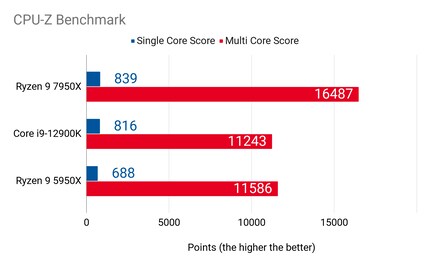
Evidently, the 7950X has successfully caught up to Intel’s 12900K in the single core benchmark, even beating it by almost three per cent. Thus, the new Ryzen CPU is 23 per cent better than its predecessor. In multi-core mode, it even beats its rival by a massive 46 per cent.
7-Zip’s built-in benchmark tests a system for compressing and decompressing data. From this, it calculates a score in giga instructions per second (GIPS). I chose the default «dictionary size» of 32 megabytes.

The 7950X pulverises all previous results. A Ryzen CPU achieves 117 per cent more GIPS than its rivals from Intel. Compared to its predecessor, there’s a 50 per cent increase in GIPS.
Blender Benchmark renders three scenes in its 3D graphics suite (version 3.3) and calculates three scores using them. I’ve added these up to give final scores for each.
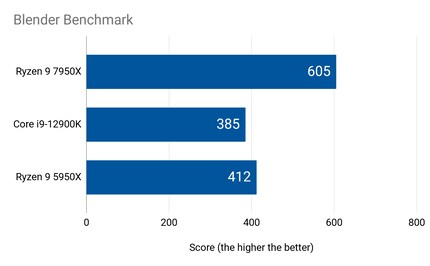
Here too, the Ryzen 9 7950X doesn’t give the competition any room to breathe: The CPU scores a whopping 57 per cent more points. Compared to its predecessor, it still increases performance by 47 per cent.
Using the Photoshop Benchmark from Puget Systems, I ran different workloads. You can find more detailed information on that here. At the end, the benchmark calculates a score based on the reference workstation.

Compared to its predecessor, the 7950X makes a huge leap forward, beating the 5950X by 36 per cent. Regarding its competition, there’s a nine per cent increase.
Using the Premiere Benchmark from Puget Systems, I ran different workloads. You can find more detailed information on that here. At the end, the benchmark calculates a score based on the reference workstation.
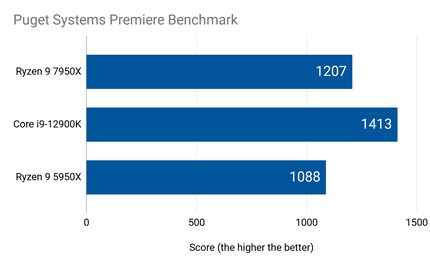
Traditionally, Intel CPUs perform better in Premiere because they’re optimised for it. Same goes for Ryzen 7000 processors. The 7950X scores 15 per cent less than the 12900K. Compared with its predecessor, there’s still an 11 per cent increase.
The PCMark 10 benchmark tests diverse scenarios such as app loading times, the efficiency of spreadsheet calculations, web browsing and photo and video editing. In other words, it demonstrates how suited a processor is to office work. From that, it calculates a score.
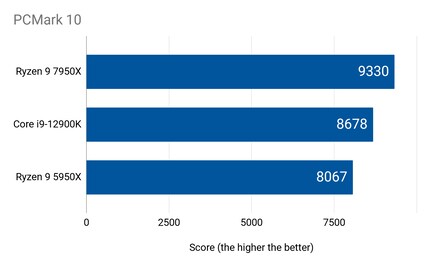
Until the 12900K, I never noticed big gulfs in performance between CPU generations for PCMark. Intel’s Alder Lake changed that, with Ryzen 7000 processors continuing this trend. The 7950X scores 7.5 per cent higher than the 12900K. Compared to its predecessor, this even reaches 15 per cent. Previously, this was usually only one to two per cent.
These synthetic game benchmarks provided a first glimpse of in-game performance. I haven’t provided the overall score calculated from the results of the graphics card and CPU. This is because I want to exclude GPU performance for CPU reviews.
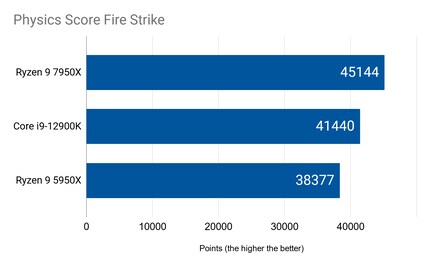
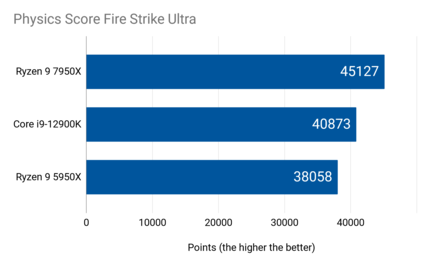
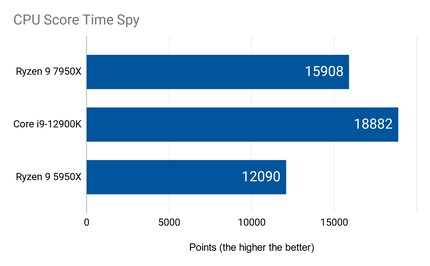

Across all four benchmarks, the 7950X scores 8 per cent higher than the 12900K. Only in Time Spy does it have to admit defeat. But compared to the previous AMD CPU, it achieves a noteworthy 23 per cent higher rating across the four benchmarks.
Synthetic benchmarks usually don’t speak the whole truth. How’s the situation in-game?
Since we can’t display image galleries, I won’t list individual game results here. You can download them in German here. The following graphics show the arithmetic mean of all nine benchmark games. I’m aware that CPU performance is mostly only relevant at 1080p and below. Nevertheless, I tested 1080p, 1440p as well as 2160p. My reasoning: you likely won’t buy a latest generation CPU and then play in 720p.

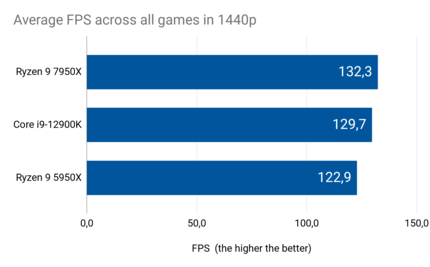
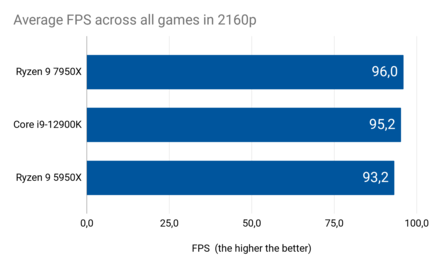
Across all resolutions, the 7950X delivers more FPS than the competition and its predecessor. As expected, these differences became smaller at higher resolutions. At 1080p it was four per cent, at 1440p two per cent and at 2160p one per cent when compared to Intel’s 12900K. Compared to its predecessor, the values are 12, 5, 7.5 and three per cent.
The 12900K delivers more FPS than the 7950X in «Anno 1800», «Civilization VI», «Assassin’s Creed: Valhalla,» and «Forza Horizon 5». However, these differences are minimal and amount to a maximum of 6 FPS. Most games run smoothly with the 7950X. However, I kept experiencing stutters in «Far Cry 6» despite the high average FPS.
The new flagship Ryzen 9 7950X processor has replaced the Intel Core i9-12900K as our best processor. AMD’s CPU takes the cake in almost all use cases.
But the reigning champion also has its downsides. Under load, the 7950X is power hungry and gets hot: 95 degrees Celsius at up to 230 watts. Compared to its predecessor, this is quite insane. Thankfully, AMD does offer Eco Mode as a less straining alternative.
At launch, the 7950X will run you 26.55 francs per thread – less than the 12900K with its 26.60 francs (prices noted the same day). The processor is well priced on its own. If you have the necessary money to spend, the 7950X is certainly worth a look. However, since AMD exclusively relies on DDR5 RAM while Intel will use both DDR4 and DDR5 in the upcoming Raptor Lake processors, Intel could have a price advantage in terms of the platform. DDR5 RAM should become cheaper in the coming months, but it’s still more expensive than DDR4. Furthermore, we simply don’t know how well Intel’s Raptor Lake processors will perform at this point in time. If you aren’t a hardcore AMD fan, I’d wait and see what Intel comes up with in the near future.
From big data to big brother, Cyborgs to Sci-Fi. All aspects of technology and society fascinate me.